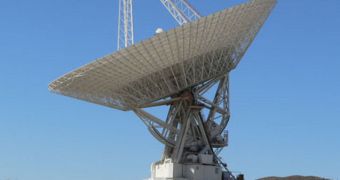Scientists at the NASA Jet Propulsion Laboratory (JPL), in Pasadena, California, announce that work has begun on repairing an iconic antenna of the American space agency. Used for the past 40 years for keeping in touch, and keeping track with deep-space missions, including those on Mars, the famous equipment now needs to have some of its parts changed. The modifications are not done willingly, but wear is beginning to hinder the good operation of the instrument, which is something that officials would have none of.
The scientific payload is situated at the Goldstone, California-based NASA Deep Space Network. The Mars antenna is gigantic, featuring a 70-meter (230-foot) dish. It is used primarily for sending and receiving signals to and from orbiters, landers and weather stations on Mars, but it can contact other spacecrafts as well, if the need arises. Now, a small portion of its hydrostatic bearing assembly needs fixing, and the task is a lot more expensive and complex than it would appear at first glance. The assembly is absolutely crucial for the antenna's ability to rotate horizontally.
“This antenna has been a workhorse for NASA/JPL for over 40 years. It has provided a critical lifeline to dozens of missions, while enabling scientific results that have enriched the hearts and minds of generations. We want it to continue doing so,” says JPL Deep Space Network Project Manager, Alaudin Bhanji. He adds that the new repairs will last for about 20 years, and that they will cost abut $1.25 million. There is some pretty tricky engineering in raising a weight of 4 million kilograms (9 million pounds) by about 0.2 inches (5 centimeters), so that experts can change the necessary pieces.
“As with any large, rotating structure that has operated almost 24 hours per day, seven days per week for over 40 years, we eventually have to replace major elements. We need to replace those worn parts so we can get another 20 years of valuable service from this national treasure,” says the JPL Deputy Project Manager for the network, Wayne Sible. He highlights the fact that it was this antenna that captured Neil Armstrong's famous message sent from the Moon, and which kept an eye on missions such as Pioneer, Cassini and the Mars Exploration Rovers (MER). All that stands in the way of accurate studies now is a degrading thin film of oil, which needs to be changed.
“The runner replacement task has been in development for close to two years. We've been testing and evaluating modern epoxy grouts, which were unavailable when the antenna was built, updating the design of the runner and designing a replacement process that has to be performed without completely disassembling the antenna. We've had to make sure we've reviewed it for practicality and safety,” concludes antenna maintenance expert Peter Hames, also from the JPL.

 14 DAY TRIAL //
14 DAY TRIAL //